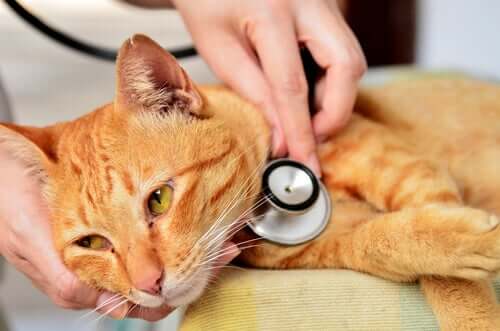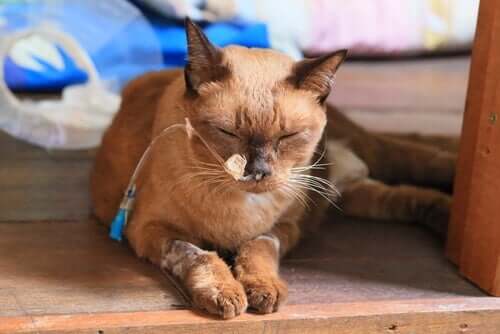Breathing Problems in Cats: What to Do

It’s important to know that, unlike other pets, breathing problems in cats can lead to serious health risks. In this article, we’ll go into detail regarding the various possible causes as well as how to react.
How do cats breathe?
Before going into the causes and solutions related to breathing difficulties in cats, it’s important to know how cats breathe. This way, if you detect any strange behavior, you’ll be able to recognize it and act quickly.
Unlike other mammals, like dogs and human beings, for example, cats only take in air through their noses. The respiratory tract of cats consists of two separate parts: superior and inferior. This means that a cat’s mouth is not part of the feline respiratory system at all.
Here are some of the symptoms we should look out for:
- Trying to breathe with an open mouth
- Very rapid or choppy breathing
- Coughing and continuous sneezing
- Other related symptoms include discomfort, fever, and nasal secretions.

If you notice any of these symptoms with relative frequency, then you need to act fast. The best solution is to go to the vet’s straight away.
Breathing trouble in cats: causes
There are a number of causes that can affect a cat’s breathing. One of the most common and principal causes is Feline Respiratory Disease Complex. This term refers to the set of diseases that attack a cat’s respiratory system. Normally, the cause is one of two viruses: herpesvirus or Feline Calicivirus (FCV).
These viruses attack the upper respiratory airways–including the eyes, nose, mouth, tongue, and throat. Besides causing breathing trouble, it also produces irritation in these areas. At the same time, this irritation causes the animal to produce more saliva, mucus and tears as a means of relief. These body fluids are the perfect means of transportation to infect other animals.
This type of transmission makes young cats who have lived in groups in shelters or with breeders especially vulnerable. If left untreated, feline respiratory disease complex can be fatal.
Feline asthma is another one of the most frequent causes of breathing trouble in cats. It tends to come from an inflammation of the bronchioles, because of some harmful or irritating substance. Feline asthma causes breathing problems, intense coughing, and noisy breathing.

As we mentioned above, there are many causes that can lead to breathing problems in cats. Below is a quick summary:
- Allergies in cats can, without a doubt, alter our cat’s breathing.
- There are certain parasites, like lungworms, that infiltrate a cat’s respiratory system.
- If your cat has accidentally swallowed a foreign object, this can also affect their breathing.
If my cat is experiencing breathing problems, what should I do?
The best course of action in the case of any of the above-mentioned signs is to take your cat to a trusted veterinarian right away. Many of these problems can quickly become very serious. Therefore, the faster you act, the more chances your cat has of a favorable recovery.
Once you see a veterinarian, they will take necessary medical measures, depending on the cause of the problem. In some cases, antibiotics or other special medications may be necessary. In the case of feline asthma, your vet may order an inhaler.
When it comes to cat owners, there isn’t much you can do besides practice preventative measures. These include strengthening your cat’s immune system, providing a good diet and keeping all its vaccinations up to date.
All cited sources were thoroughly reviewed by our team to ensure their quality, reliability, currency, and validity. The bibliography of this article was considered reliable and of academic or scientific accuracy.
- Gómez, N., Pisano, P., Castillo, V., & Fontanals, A. (2012). Asma felino: fisiopatología, diagnóstico y tratamiento. InVet, 14(2), 191-207.
- Cohn, L. A. (2011). Feline respiratory disease complex. The Veterinary clinics of North America. Small animal practice, 41(6), 1273-1289.
- Azócar, L., Tamayo, R., & Thibaut, J. (2008). Estudio retrospectivo de las enfermedades respiratorias en felinos diagnosticadas clínicamente en el Hospital Veterinario de la Universidad Austral de Chile, Valdivia, durante el período 1997-2004. Archivos de medicina veterinaria, 40(3), 289-294.
- Palmero, M. (2019) Disnea Aguda, Ronquidos, Sonidos inspiratorios… y ahora ¿qué hago?. Congreso Veterinario Ibiza. Recuperado el 28 de marzo de 2022, disponible en: https://congresoveterinarioibiza.com/wp-content/uploads/Disnea-aguda-ronquidos-sonidos-inspiratorios…-M.-Palmero.pdf
- Palmero, M. L., & Felino, G. C. C. Calicivirus Virulento Sistémico (VS-FCV). Obtenido de Gattos Centro Clínico Felino: https://www. gattos. net/images/Publicaciones/Marisa/ArticulosNuevos/7ACaliciv irusVirulentoSistemico. pdf.
- Dambolena, I., Paludi, A., Nieto, M. & Dolcini, G. (2017) Calicivirus felino en gatos vacunados. (Tesina de grado, Universidad Nacional del Centro de la Provincia de Buenos Aires).
This text is provided for informational purposes only and does not replace consultation with a professional. If in doubt, consult your specialist.